
Search
The Renewable Energy site for Do-It-Yourselfers
Earthship Water
System
|
Here are some highlights of the Earthship system
for catching water, reusing water, and treating waste water.
Amazingly, Earthships in Taos, which
gets only 8 inches of rain, are able to supply all their water needs from water
collected from the roof. This is accomplished through a well
designed catchment system, water conservation, and water reuse.
The typical water use per person in
the US is about 80 gallons per day, the Earthship is designed to drop that use
per day down to 20 gallons. With this lower water usage, even
Earthships in low rainfall areas are able to capture sufficient water from the
roof to be self sufficient. Water usage is reduced by using grey water for
toilet flushing, low flow shower heads, low water use washing machines, hand
dish washing, and by not using water for an evaporative cooler (which is not
needed).
|
|
Earthships also contain a simple mini
sewage treatment plant. The Earthship does not export sewage to a sewer
system or put sewage into the ground.
To me, this water management system
is the Earthships most impressive feature. The fact that this can all be
accomplished with simple designs that you can build yourself makes it all the
more amazing.
The Michael Reynolds book "Water From
the Sky" covers the entire system in quite a bit of detail, and is well worth the
read even if you don't plan to build an Earthship -- many of the concepts and
designs will work in other types of residences. You can get the book from
Earthship central: www.EarthShip.com
Highlights of the Water System
The water system has three main
components:
-
The water catch (roof, cistern, and
water filtering)
-
The grey water treatment and reuse
system
-
The black water treatment system
Here are brief descriptions and some
pictures of each of these system to whet your appetite. The book mentioned
above provides descriptions of these systems that are sufficiently complete to
build from.
Water Catch
The Earthship roofs are carefully
designed to catch every drop of rain that falls on them. The rainwater
from the roof if collected in one or more cisterns. The cistern is usually
an integral part of the Earthship.
Roofs:
The roofs are designed with water
collection in mind -- in a nutshell this means:
-
Shaping the roof to collect water
-
Using roof materials that can
collect water cleanly
-
High capacity water collection
troughs or gutters that route the water to the cistern
-
Filtering out junk in the water so
it does not get in the cistern
-
Keeping all the parts from freezing
-
Orienting the roof so that snow
does not evaporate before it gets collected
One message here is that an efficient
roof/cistern water catching system should be a part of the design from the
start. You can probably catch some water from any roof, but to catch clean
water efficiently calls for a roof that is designed for that purpose.
Typically the Taos Earthship roofs
have low sloping roofs that face south. The lower slope allows for better
collection and doesn't let your valuable snow slide off the roof. The
south facing roof slopes ensure that the snow melts and gets collected before it
evaporates. The south facing arrangement also reduces freezing problems.
The Earthship crew have tried a
number of roof types -- here are the ones that can work:
-
Metal roofing -- long life, clean
water, but impossible to form into curves.
-
Cement Plaster coated with Acrylic
coating -- any shape you want, but the plaster cracks and the Acrylic coating
require maintenance.
-
EPDM -- good roof and clean
collection, but requires professional installation
-
Brai with Acrylic coating -- adapts
to shapes, good clean collection with Acrylic coating
The book goes into much detail on the
pros/cons of each type.
The Hut Earthship uses the Cement
Plaster coated with Acrylic coating. Here are some pictures of the Hut
roof and cistern:
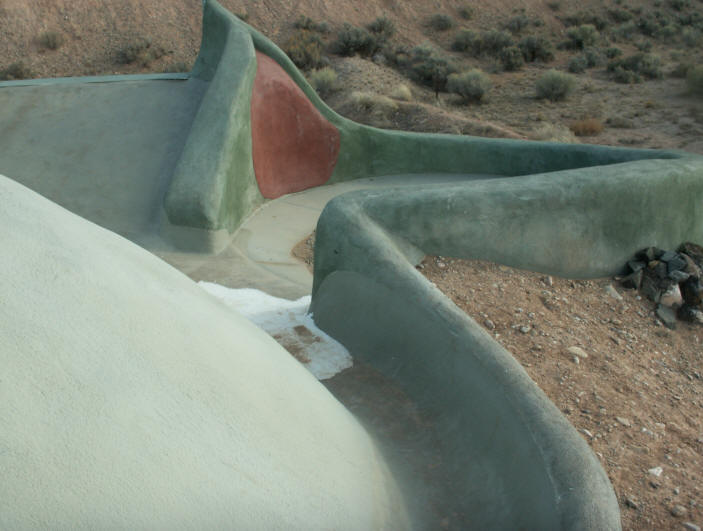
The Hut roof looking East -- one of
the two roof domes min foreground, and trough leading to cistern area.
Dirt slope to the right is the north wall berm.
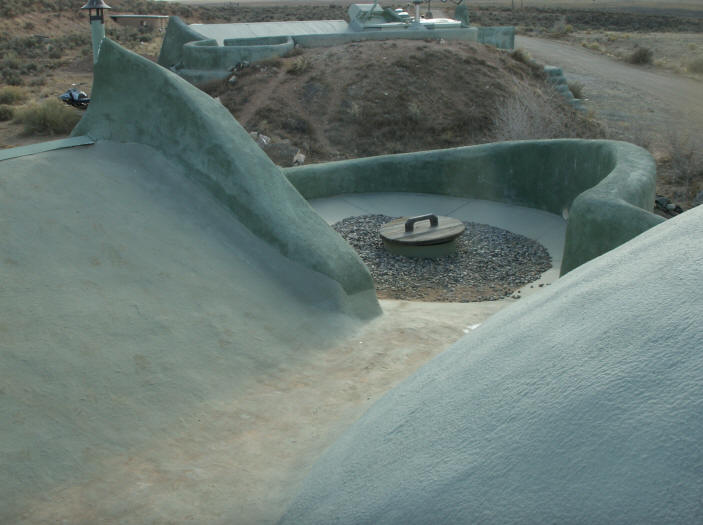
Hut Roof -- The trough leading to
cistern. The upslope to the left is the south side roof kickup for the
window wall, and one of the two roof domes is in the right foreground. The
wood lid on the cistern is visible, and the gravel filters out debris before the
water enters the vertical tube through small holes that are below the gravel
surface. This type of debris filter is somewhat self cleaning, as the wind
tends to blow away loose debris.
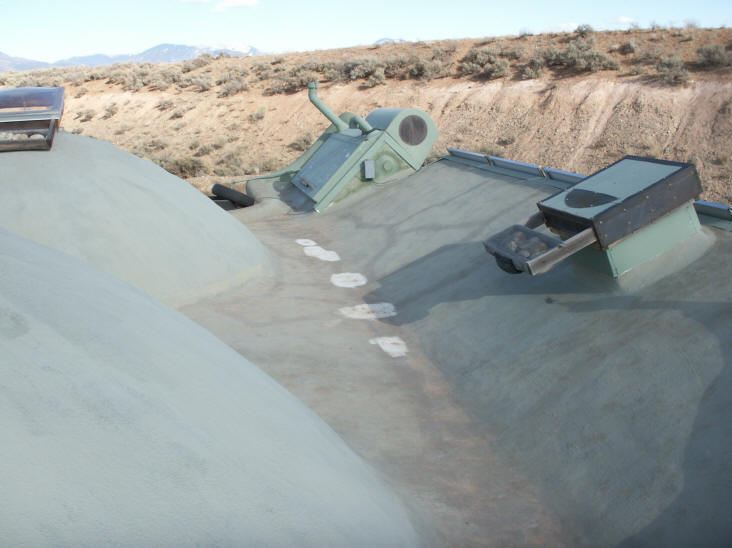
Hut Roof -- looking up the collection
trough to the East (away from the cistern). Note the small repairs in the
Acrylic coating. The two main roof domes are to the left (North).
The tank for the thermosyphon water heater and the batter storage compartment
for the PV system batteries are on the seen on the East end of roof. Two
of the openable sky vents are also visible. The sky vent in the foreground
is over the kitchen area. The sky vents are counterweighted by the rock
weights at the end of the 2X4 arms. The sky vent is held down by a cleated
rope from the inside, and opens under the influence of the counterweight when
the rope is released.
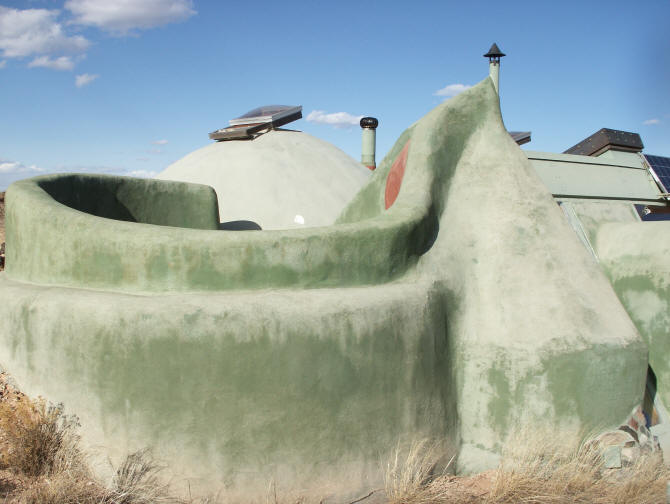
Looking at the cistern from the
ground with one of the roof domes in the background -- from the SW.
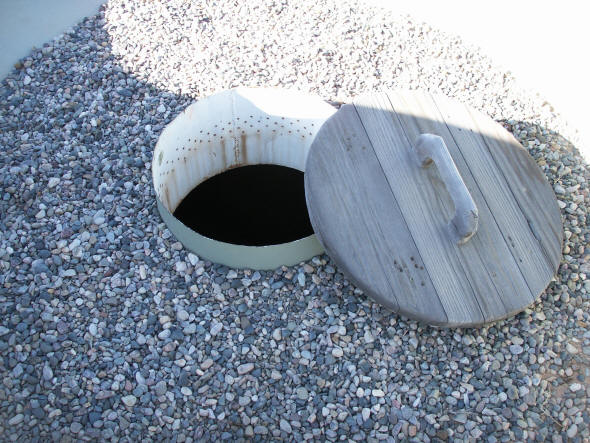
The cistern lid. Note the small
holes in the vertical tube where the water enters the cistern. The
proximity to lots of cistern water at about 40F keeps this from freezing in the
winter.
Cistern:
The cisterns catches and stores water
for later use. Water is pumped from the cistern when needed.
The cisterns are arranged such that
water can flow off the roof by gravity to the cistern inlet, and so that cistern
outlet can gravity feed the pump inlet. Basically, this means the top of
the cistern needs to be at or below the roof level, and the bottom of the
cistern should be at or above the Earthship floor level.
Typically the cisterns are earth
bermed and integrated with the Earthship structure, which keeps them from
freezing.
The inlet to the cistern includes a
debris filter to keep junk from getting into the cistern -- see picture above.
For the Earthships, cisterns are
normally either plastic tanks, or cement plaster tire walls with an Acrylic
coating. The use of galvanized tanks is not recommended because the
eventually rust.
Water Distribution System:
The water distribution system for the
Earthships consists of:
-
A 12Volt Dc pump that draws water
from the cistern
-
A set of filters that filter the
water before it is used in the Earthship
-
A pressure tank that fed by the
pump, and supplies pressurized water to the Earthship faucets and appliances.
-
A solar water heater that heats
water bound for the hot water faucets.
-
A backup water heater -- normally a
tankless (demand) gas heater.
All of the pump and filter components
are typically mounted on a board like the one pictured below. These can be
supplied by the Earthship crew, which simplifies the plumbing.

The "WOM" -- Water Organizing Module.
Cistern water enters at left and goes through the 60 mesh filter before arriving
at the pump inlet. The pump outlet goes to a 500 mesh filter. At
this point water for the kitchen sink and shower is taken off. Drinking
water goes through the last two filters to special faucets in the kitchen and
bathroom for drinking water.
The 12 volt DC pump is a Shurflo, and
looks similar to the type used on RV's. The pump turns on when the
pressure tank pressure gets down to about 20 psi, and turns off when the
pressure tank gets up to about 50 psi.
The pump is located as low as
possible in order to keep its prime from the cistern.
The WOM can be purchased as a
completely plumbed module from Earthship central.
The odd looking pipe loop in the
foreground is because the solar water heater had been bypassed for some reason.
Grey Water
Black Water






